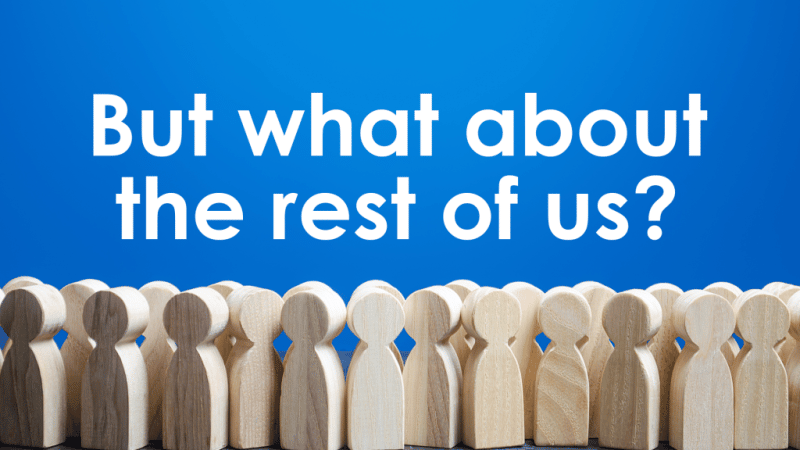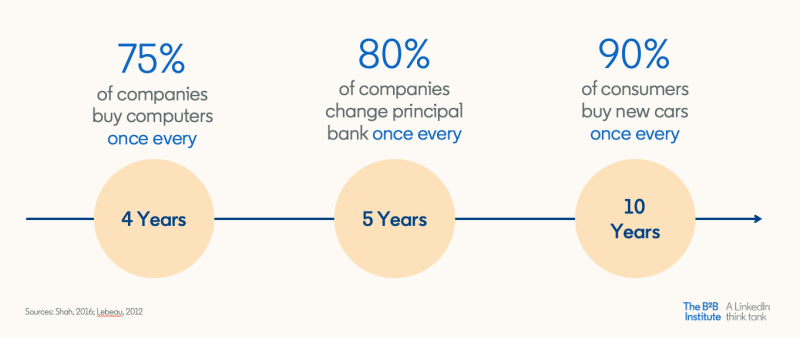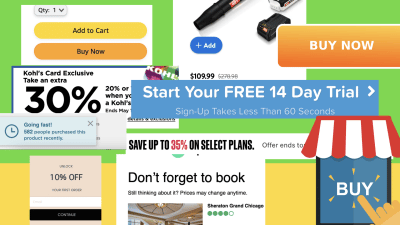
“Click here to buy now”
“Subscribe and save”
“Add to cart”
“Other people also have it in their cart”
“You left something in your cart. Are you sure you don’t want to go back and buy that thing in your cart right now?”
“Good God! There’s a countdown clock!! Buy it NOW or we will never sell it to you again!!!”
All those hyperventilating buttons assume the customer is in the market for this thing right now. Indeed, most advertising is built to close the deal today.
But…what about the rest of us?
Most people aren’t in the market right now. Not just “most,” I’m talking 95% of the people don’t need what you’re advertising right now.
A recent LinkedIn publication shows businesses change firms every 5 years on average. This means only 5% of businesses are in the market to buy something every quarter.
Professor John Dawes from the Erhenberg-Bass Institute says this is true for everyday products, too. Most will purchase a car once in 5 to 7 years. This means in any given month only 1.6% of people are shopping this month.

Mattresses are purchased once every 9 years, meaning the last commercial you saw for a big mattress sale was wasted on 99.1% of the public who don’t want a mattress at any price. They won’t buy a mattress no matter how low the price…because they just don’t need one.
The direct response ad industry, which includes most of what you see online, is built upon hyper-targeting to those scant percentages of people shopping today.
If you’re not shopping today, to hell with you. You’re of no use to us.
But does that feel right to you?
Are future customers useless to you?
If a customer in the store is the only customer who matters…why bother putting a sign outside? Why drive around with your name on your vehicle? Who needs a website when drip campaigns sell stuff?
Why do we need farmers? All the food you need is at the grocery store.

When you begin to realize that most of the people you are talking to have no need for your product right now it should instruct how you advertise. This doesn’t really change your dollars, instead, it changes how you apply them.
More importantly, it changes what you say.
Your goal is to intentionally, deliberately, work to build trust and likability. These are the positive messages that help the future customer remember you tomorrow. These are messages not about you, your offerings, and discounts… instead they are stories about your customer and how she’ll feel once you’ve solved a problem she doesn’t yet have…
…but will one day.
You see this play out in product after product, decade after decade. The stalwarts like Crest and Colgate dominate their category because they’ve worked diligently to tell you what they believe and how that matches with what you believe.
You see the opposite in the jewelry store you never hear from until Valentine’s Day or the florist that only appears around Mother’s Day.
“Who are these people? ”
“Can I trust them?”
“They only seem to show up when I have money to spend.”
“Maybe it’s just easier to go online. At least I’ve heard of those companies”
Of course you need to sell things today. Even if only 1.6% of the people need a car this month, in a city the size of Akron, Ohio it’s still about 3,000 people. They’re certainly important. The good news is there are dozens of effective tools to help you sell something today.
The bad news is, if you ignore the other 175-thousand people in Akron by only talking about your big sale today, you’re going to have a hell of a time selling to them tomorrow.

- Emotion in Advertising Equals Dollars in Business - December 3, 2024
- 2024: The Year Digital Becomes “Traditional” - July 10, 2024
- MYTH: Everyone goes to Google first - June 26, 2024
